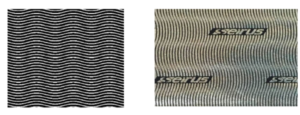Columbia Sportswear is the owner of U.S. Patent D657,093 (“the ‘093 patent”), a design patent directed at the “ornamental design of a heat reflective material.” The claimed design is a wave pattern used in sleeping bags, boots, pants, gloves, and jackets. Columbia sued Seirus Innovative Accessories in the District of Oregon for infringement of the’093 patent and a utility patent. Seirus makes outdoor apparel products lined with its HeatWave fabric, and its design features waves of varying pattern and orientation, interrupted by repeated use of the “Seirus” logo.
 Columbia ‘093 Patent Seirus Heatwave
Columbia ‘093 Patent Seirus Heatwave
The district court granted summary judgment in favor of Columbia, finding that Seirus’s HeatWave products infringe the ’093 patent. The court held that the “ordinary observer” for the design patent infringement analysis would be the end buyer and user of Seirus’s gloves and products. Next, viewing the designs side-by-side, the court determined that “even the most discerning customer would be hard pressed to notice the differences between Seirus’s HeatWave design and Columbia’s patented design,” characterizing the difference in wave pattern, orientation, and the presence of Seirus’s logo as “minor differences.” The district court declined to consider Seirus’s logo placement because logo placement was not claimed in the ‘093 patent. The court relied on L.A. Gear, Inc. v. Thom McAn Shoe Co., Inc., 988 F.2d 1117 (Fed. Cir. 1993) for the proposition that logos should be wholly disregarded in the design-infringement analysis. The decision ultimately resulted in a damages award of over $3 million dollars to Columbia.
Seirus appealed the decision to the Federal Circuit, arguing, inter alia, that the repeating Seirus logo boxes were an integral part of the HeatWave design, and that excluding these elements simply because they included a logo was at odds with the ordinary observer test. In a precedential decision, Circuit Judges Lourie, Moore, and Stoll held that the district court erred in declining to consider the effect of Seirus’s logo in its infringement analysis. The panel explained that although L.A. Gear stated that design infringement could not be avoided simply by labelling, “L.A. Gear does not prohibit the fact finder from considering an ornamental logo, its placement, and its appearance as one among other potential differences between a patented design and an accused one.” According to the panel, ignoring elements of the accused design merely because they include the defendant’s name would be inconsistent with the ordinary observer test.
Implications for Patent Law Litigation
The Federal Circuit ruling seemingly expands the role that logos can play in the analysis of similarities between design patents and potentially infringing designs. The decision allows for a fact finder analyzing substantial similarity to “[consider] an ornamental logo, its placement, and its appearance . . . among other potential differences between a patented design and an accused one.” A fact finder is given the task of determining whether the overall effect of a design is substantially similar to another which the Federal Circuit has now determined necessarily includes analysis of design elements that include the name or logo of a company if they are incorporated in the overall design. On January 14, 2020, Columbia filed a petition for an en banc rehearing, urging the full Federal Circuit court to reverse the panel’s decision. According to Columbia, the panel’s decision “substantially alters well-settled design patent jurisprudence and will have a significant, detrimental effect on the value of design patents,” and “design patents will be effectively rendered meaningless if slapping one’s own brand name or logo on another’s design is sufficient to avoid infringement.”
In the future, it is important to consider names or logos incorporated in potentially infringing designs both during patent prosecution and when considering litigation. It is important to seek counsel to develop litigation strategies and prepare for potential patent prosecution in light of these considerations.